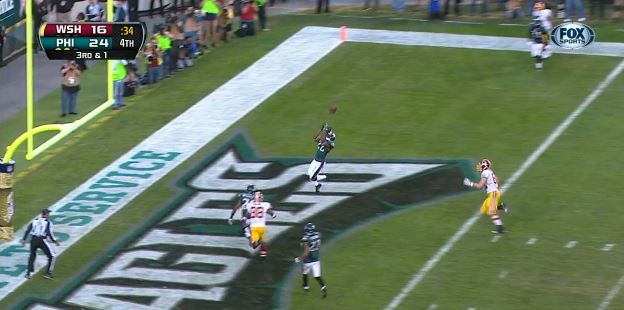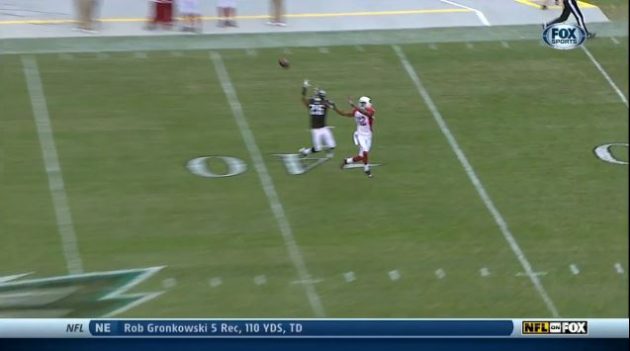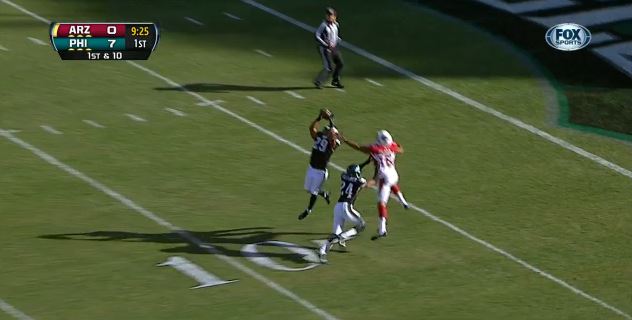Eagles’ Takeaways Are No Accident
In Chip Kelly’s final season at Oregon, the Ducks’ defense led the nation in takeaways with 41. They finished second in that category in 2010.
In his two-year stint as defensive coordinator in Arizona, Billy Davis’ units were sixth in takeaways both seasons, generating 59 in all. He had similar success in that department as DC in San Francisco.
The 2013 Eagles are currently ninth in the NFL with 22 takeaways, and gaining steam. Nine of those have come during this current four-game winning streak.
What is it about the concepts and teachings of this coaching staff that helps create a turnover-friendly environment? Let’s take a look:
The scheme
A major benefit of deploying a two-gap 3-4 is that it frees the safeties of certain responsibilities in the run game.
“The 3-4, you really don’t have your safeties responsible for certain gaps,” said Nate Allen. “You’re not playing quarters and also have to fill up a ‘B’ gap or something like that because, you know, that’s when you start biting on play action and stuff and things start going downhill.
“It alleviates somebody from having to come down and be responsible for a gap, and usually that’s your safety guy that’s coming down for that extra gap.”
The safeties were overloaded with run responsibilities last season, which had plenty to do with why they got burned over the top so frequently. This year things are much different.
“The secondary, we’re pass guys, that’s our main focus,” said Allen. “The run game, as far as gaps and where we’re fitting, we really don’t [have to worry about that.] We’re pass first, pass second and then pass third.”
As the ball is snapped on 1st-and-10 from the Philadelphia 39, Allen doesn’t look to have a care in the world about the run game.
And that’s good because play-action is coming.
Allen is free to survey the field as the play develops. Palmer will target Michael Floyd (at the bottom of the shot). Allen comes over to assist Bradley Fletcher in coverage. Up front, DeMeco Ryans gets home on the pass rush and prevents Carson Palmer from following through on his throw.
The pass comes up a little short as a result, and Allen is able to elevate and make the play.
“I think a lot of times when you don’t have to devote that second safety to the box, he can see the football. Now they have a better chance to break on footballs,” said Kelly. “When you can cause a pass‑rush with four guys and get to the quarterback a little bit, now we have guys who have eyes back to the quarterback and kind of locate it. If you don’t let the quarterback get his feet set and feel comfortable back there, he may throw one up or serve one up for him. Billy said it all along, I felt as our defense continues to understand the techniques and what we’re trying to do, that they’re going to come in bunches, and they’re starting to come in bunches, which is a positive thing for us.”
Coaching
The players get a kick out of watching the coaching tape, and seeing a crazed Jerry Azzinaro bolting up and down the sidelines.
The defensive line/assistant head coach is always stressing to his players to run towards the ball, even if they think they are out of the play. There’s a chance that the ball comes out or takes a funny hop, and he wants his guys in position just in case.
It’s important to practice what you preach.
“If you watch Azz out there, as soon as they hand the ball off or the quarterback throws it, he runs in the general direction [of the ball] just telling us to go,” said Casey Matthews. “It’s actually funny when you watch it on film, there’s no sound but you see him just run. He’s got this awkward running [motion]; it’s pretty good.”
The message is getting home, though. Consider the following play a couple weeks ago against Green Bay:
Scott Tolzien is getting ready to release the ball and as you can see, he’s going right. Ryans (bottom left) is on the other side of the field.
Cary Williams challenges the throw and forces a deflection. The ball would have harmlessly fell to the turf if Ryans did not stick with the play.
But he did, and is able to make a diving grab for the interception.
Even on incomplete passes the defenders are told to scoop the ball off the ground just to get in the habit in the event of a fumble. In pre-practice they work on what they call a “city fumble,” which means the ball is loose amid a lot of bodies, and the defender jumps on it. A “country fumble” is in wide-open space and the player is asked to scoop and score.
The strip sack is also something that the players routinely work on.
Several trash cans were lined up a few yards apart from each other on one section of the practice field Wednesday. The linebackers and defensive linemen had to maneuver past them before making a B-line for an assistant coach, who was playing the role of the quarterback during this drill. As the defender approached the coach raised the ball over his head and the defender had to try and swat it out.
A couple players said that as the season has worn on, you can see the defense going after the ball more instead of focusing just on the quarterback hit. Such was the case with Trent Cole against the Cards.
The defensive backs are routinely put through a “deep ball drill” at practice where a quarterback fires the ball down the field, and the DBs have to sprint after it before jumping into the air to secure the interception. They go through a similar routine during pre-game warm-ups.
It kind of looks like this:

And this:

And we saw it on that Allen interception as well.

“We emphasize two feet off the ground catching the ball. It’s just something that they get used to doing and are comfortable doing it,” said defensive backs coach John Lovett. “They have to be the receiver down the field, they can’t worry about defending the receiver. When the ball’s in the air they have to go be the receiver.”
These are the kind of little things that are drilled on a regular basis. Nothing out-of-the-ordinary, but it’s interesting to see how practice habits can carry over to the field.
That covers general philosophy and fundamentals. The last piece of the puzzle is the game plan. And that’s where Davis comes in.
“I think you have to give a lot of credit to Billy Davis and the coaches because our scheme is pretty confusing I think for quarterbacks to understand what we’re doing,” said Connor Barwin. “You see a lot of teams that play a lot of man-to-man, they don’t get a lot of turnovers because of the nature of playing Cover-1 man-to-man. But we play a lot of zones — different zones — and I think it’s hard for quarterbacks to really zero in on what they’re doing. That’s how you get quarterbacks to make wrong decisions or bad throws.”
Put it all together, and you have a defense that is starting to generate turnovers at a pretty good rate.